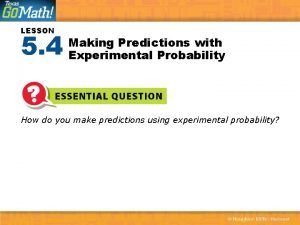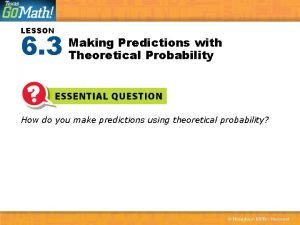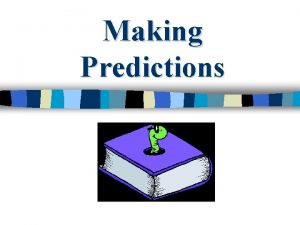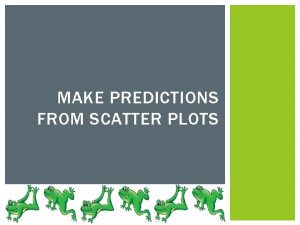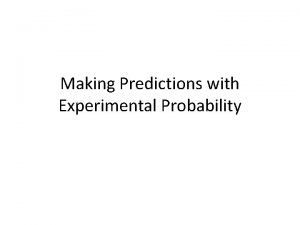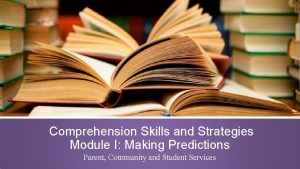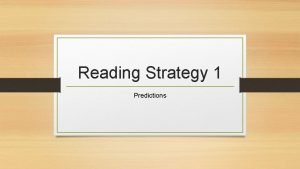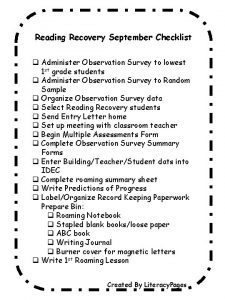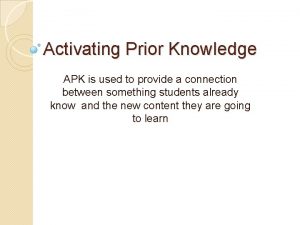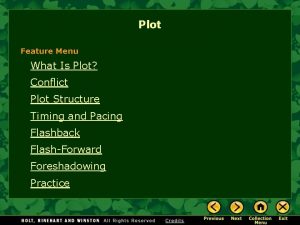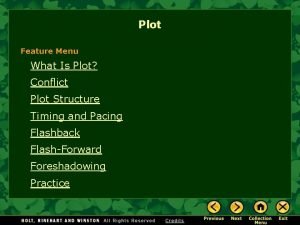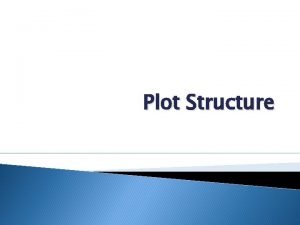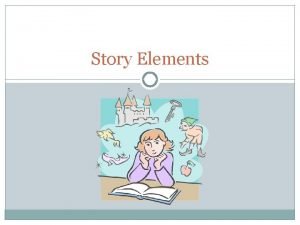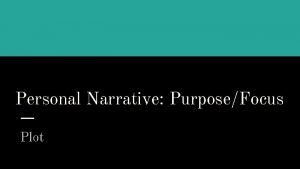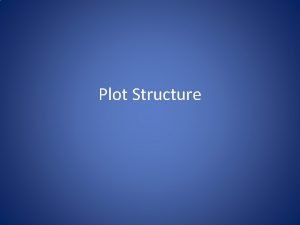Using Prior Knowledge to Make Predictions PLOT Reading











- Slides: 11

Using Prior Knowledge to Make Predictions PLOT

Reading Skill: Making Predictions • Predicting means making an intelligent guess about what will happen next in a story based on the details in the text. You can also use prior knowledge to make predictions. • For example: If a character in a story sees dark clouds, you can predict that there will be a storm because you know from prior knowledge that dark clouds often mean stormy weather.

Making Predictions • Making predictions while you read involves you in the story. As you read, use details from the story and your prior knowledge to make predictions about what the characters will do.

Practice Predictions • The weather report said that there was a fifty percent chance of rain this morning. I looked out my window and saw the sun shining. I remembered that yesterday the weather report predicted the same chance of rain, but it never did rain. So, I predict that today it will not rain. I will check the sky again later. If it is not raining, I can confirm my prediction. If it is raining, then I will adjust or correct my prediction.

• What parts were used as available information? • What part was used as a personal experience? • How was the prediction going to be confirmed? What was the prediction based on?

Literary Analysis: Plot • Plot is the related sequence of events in a short story and other works of fiction. A plot has the following elements: – Exposition: introduction of the setting, the characters, and the basic situation – Rising Action: events that introduce a conflict, or struggle, and increase the tension – Climax: the story’s high point, at which the eventual outcome becomes clear – Falling Action: events that follow the climax – Resolution: the final outcome and tying up of loose ends

Plot Graphic Organizer Climax Event #4_______ Exposition n tio Ac Ris Event #1____Event ing Event #2____ on cti g. A llin Fa Event #3____Event Resolution

The Bear Boy By: Joseph Bruchac In “The Bear Boy”, a man neglects his son and does not teach him the ways of Pueblo life. One day, the boy follows some bear tracks. He meets and becomes friends with bear cubs and is adopted by their mother. The bears teach the boy how to be confident and live in a community. When the boy’s father tries to rescue the boy, he learns several lessons. Both learn to appreciate the bears and the importance of caring for one’s own family.

The Bear Boy Vocabulary • Timid – Showing shyness – The timid child was afraid of me. • Initiation – process by which one becomes a member of a group – Jo looked forward to her initiation into the Honor Society • Neglected – failed to take care of – The cat neglected her kittens, so we raised them.

Background Animals in Native American Folk Tales In early times, Native Americans depended on animals for food, clothing, and shelter. As a result, Native Americans felt gratitude toward animals and included them as important characters in their oral stories. “The Bear Boy” is a Native American story that focuses on a mother bear and her cubs.

Reading/Writing Connection • Usually, people think of themselves as teaching animals rather than as learning from them. However, many Native American groups believe animals have a lot to teach us. List the lessons that people might learn from animals. Use at least three of the following words: • Appreciate • Instinct • Observe • Survive
 How do you make predictions using experimental probability
How do you make predictions using experimental probability How do you make predictions using theoretical probability
How do you make predictions using theoretical probability Good readers making prediction by
Good readers making prediction by Make a prediction
Make a prediction Can you make predictions about tech devices
Can you make predictions about tech devices Making predictions with probability
Making predictions with probability It's your turn to make predictions
It's your turn to make predictions Might for predictions
Might for predictions Making predictions practice
Making predictions practice What is this font
What is this font Observation survey summary sheet
Observation survey summary sheet Activating prior knowledge examples
Activating prior knowledge examples
